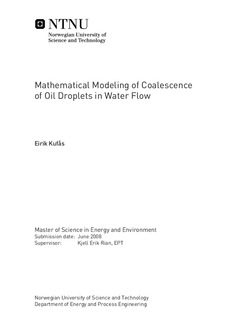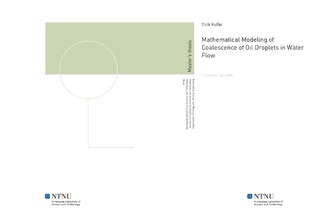| dc.contributor.advisor | Rian, Kjell Erik | nb_NO |
| dc.contributor.author | Kufås, Eirik | nb_NO |
| dc.date.accessioned | 2014-12-19T11:46:19Z | |
| dc.date.available | 2014-12-19T11:46:19Z | |
| dc.date.created | 2011-06-27 | nb_NO |
| dc.date.issued | 2008 | nb_NO |
| dc.identifier | 426918 | nb_NO |
| dc.identifier | ntnudaim:4339 | nb_NO |
| dc.identifier.uri | http://hdl.handle.net/11250/234232 | |
| dc.description.abstract | Liquid-liquid coalescers are devices used for increasing the droplet size of the dispersed phase in continuous phase flow, such as oil droplets in water flow. The efficiency of separation technologies is strongly dependent on the droplet size, which is desirable to shift into larger droplet diameters. Theory behind coalescence and its modeling is studied in this Maser s thesis. Aker Process Systems AS, Division of Advanced Separation Technology, provided the assignment proposal.The scope of this work is a literature study on the coalescence phenomenon and the closely related break-up phenomenon and CFD modeling in general. Further a mathematical model for simulating coalescence of oil droplets in continuous water flow is developed by the use of the commercial CFD-code FLUENT. The basis for the model is a swirl-based coalescer called Compact Tubular Coalescer (CTC), developed by Aker Process Systems AS.The validity of the model is evaluated before different aspects of the performance of the coalescer are studied. Several validation criteria were tested and were acceptable, but some weaknesses regarding lack of test cases were detected. The performance testing showed good performance of the CTC, it was able to increase the Sauter Mean Diameter (SMD) of the droplet with up to 250% for the smallest droplets (20 μm) and highest volume fractions (7%). Remarkable differences of the performance were observed as the physical properties were changed. Higher viscosity and droplet surface tension lead to increased coalescence rate and decreased break-up rate.Future work is recommended to concentrate on improving the present model and to investigate more aspects of the model. An effort should also be made to use a Eulerian approach to model the dispersed phase with the use of population balances, in order to be able to simulate flows with larger dispersed phase volume fractions. | nb_NO |
| dc.language | eng | nb_NO |
| dc.publisher | Institutt for energi- og prosessteknikk | nb_NO |
| dc.subject | ntnudaim:4339 | no_NO |
| dc.subject | MIENERG energibruk og energiplanlegging | no_NO |
| dc.subject | Varme- og energiprosesser | no_NO |
| dc.title | Mathematical Modeling of Coalescence of Oil Droplets in Water Flow | nb_NO |
| dc.type | Master thesis | nb_NO |
| dc.source.pagenumber | 72 | nb_NO |
| dc.contributor.department | Norges teknisk-naturvitenskapelige universitet, Fakultet for ingeniørvitenskap og teknologi, Institutt for energi- og prosessteknikk | nb_NO |

